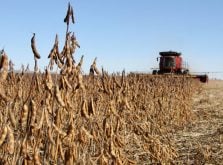Is the Canadian canola crushing industry about to walk into the same trap that wrecked the grain companies’ balance sheets in the 1990s?
“The risk is there, absolutely,” said Hartley Richardson, head of James Richardson and Sons, which controls James Richardson International and a number of other family companies.
“There’s always that risk, as there was with too much overbuilding with the grain handling area, that this could happen in the processing area as well.”
Richardson’s 149-year-old company announced July 5 that it was planning to build an 840,000-tonne-per-year canola crushing plant somewhere in Saskatchewan, Manitoba or North Dakota.
Read Also

Manitoba extends Crown land rent freeze
Manitoba government links the continued rental rate freeze on grazing and forage leases to economic and environmental challenges facing the industry
That plant alone will consume up to 10 percent of the Canadian crop. It is planned to come on-line within a couple of years of the crushing expansions occurring now at the Bunge plant in Nipawin, Sask., and the Archer Daniels Midland crushing and biodiesel plant in Velva, N.D.
Richardson doesn’t believe building the JRI plant will glut the market, but it will push capacity close to maximum.
“This is a large plant and there could possibly be one other facility built, but any more than that would clearly be a challenge to make the economics work,” said Richardson.
Building too much capacity can destroy profitability for all grain and food companies, as happened in the 1990s after Saskatchewan Wheat Pool launched a concrete elevator construction boom with its cross-prairie Project Horizon.
That initiative provoked other grain companies into major construction programs to retain their share of the market, leaving a lot of red ink on companies’ financial statements.
Companies fought for farmers’ grain at the same time they were borrowing enormous amounts of money to build new facilities, while new, non-Canadian competitors like ConAgra and Louis Dreyfus arrived and built their own facilities. Companies like Sask Pool, Manitoba Pool Elevators and Alberta Wheat Pool all ended up with financial problems, mostly due to the capital programs.
University of Manitoba economist Ed Tyrchniewicz said companies need to learn from the 1990s experience. There’s a danger that too many competitors might launch their own projects at the same time. Companies involved in prairie crushing shouldn’t assume they’re the only players who are going to get involved.
“It depends who gets into the Canadian crushing industry,” said Tyrchniewicz.
Ag Commodity Research analyst Nolita Clyde said JRI’s announcement is no shock to the industry.
“People have been expecting that somebody would bite the bullet and do this,” said Clyde.
Barb Isman of the Canola Council of Canada said she doesn’t think this one plant will fill all the demand for canola oil that is likely to soon arise, so JRI’s plant won’t be the end of the crushing expansion.
“I don’t think it’s the last one,” she said. If the Canadian government soon announces biodiesel incentives that roughly match American incentives, more crushing plant announcements are likely.
“Once the government moves, it won’t drag on,” said Isman.
“There will be a lot of action, fast.”
Making announcements well ahead of construction has sometimes been used as a strategy by companies warning competitors away from duplicate projects.
That appears to be the case here. Richardson said JRI wants its competitors to know that any other new projects won’t be alone in the market.
“We are proceeding. The other companies will have to factor that in to their decision making process if, in fact, they’re looking at this at all,” said Richardson.















